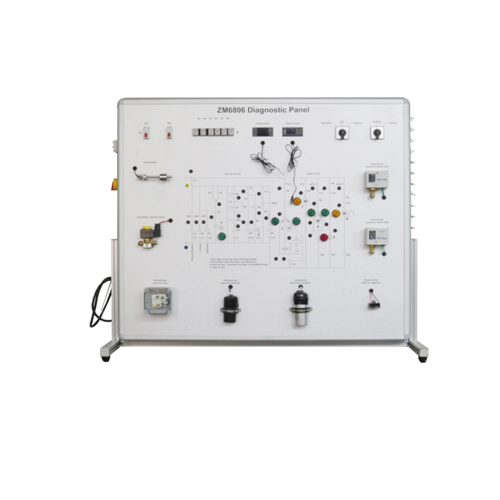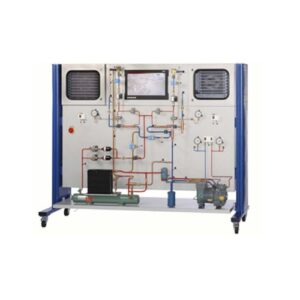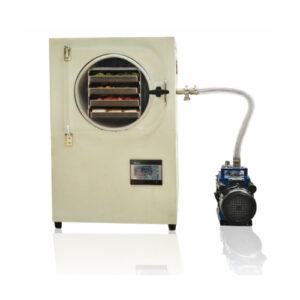AZM6806 Diagnostic Panel Teaching Equipment Refrigeration Laboratory Equipment
I. Product overview
The principle and process of air conditioning and refrigeration
Air conditioning is short for air conditioning. The main content of the air conditioner is refrigeration, which is artificially made to cool. To understand the principle of air-conditioning and refrigeration, we must first understand the principle of evaporative heat absorption. For example, we have all given injections. When the nurse rubs alcohol on our skin, we immediately feel that the place being rubbed is so cool. Why? This is the result of alcohol evaporation, which absorbs the heat from our skin so we will feel cool. If you put water on your skin, it will feel cool, but it is not as effective as alcohol, because alcohol evaporates more easily than water, which means that the faster it evaporates, the better the cooling. The factors that affect the speed of evaporation are temperature. The higher the temperature, the faster the evaporation. For example, clothes washed in summer dry faster than in winter.
There is also pressure. The lower the pressure, the faster it will evaporate. For example, if you boil water in the plains, you will get 100 degrees, while in the Qinghai-Tibet Plateau, you will boil less than 90 degrees. Because the boiling point is different, water does not boil and evaporate in large quantities until it reaches 100 degrees. However, our air conditioner uses fluorine. Fluorine turns on at minus 30 degrees. When it boils, it evaporates a lot. If we pour fluorine into a water tank, it will evaporate a lot at room temperature and absorb the surrounding heat. The water tank and its surroundings will be very cold. We use a fan to blow the water tank, and the cool breeze will be blown out. But this is a hypothesis, which is not practical, because the fluorine we poured in evaporates immediately, and it is impossible for us to continue to fill it with fluorine. Then how can we reuse fluorine? First of all, we have to find a way to restore the fluorine that has become vapor to liquid fluorine. One way is to pressurize. As long as the gas is pressurized, the gas can be turned into liquid, and the higher the pressure, the easier it is to turn into liquid. For example, the liquefied gas tanks used at home are mostly liquid, which is the compressed liquid of liquefied gas. Another method is cooling. As long as the gas is cooled, the gas can be turned into liquid, and the lower the temperature, the easier it is to turn into liquid. For example, when water is boiled in a pot, there are drops of water on the lid. This is the result of condensation of water vapor in the pot on the colder lid. To solve the problem of changing gas to liquid, there is also a closed system to prevent fluorine from leaking. It becomes an air conditioning system.
The air conditioner is mainly composed of four parts: compressor, condenser, throttling device and evaporator.
When refrigerating, the compressor sucks the low-temperature and low-pressure fluorine gas in the evaporator (indoor unit) into the cylinder, and compresses it by the compressor to turn it into a gas with higher pressure and temperature and introduces it into the condenser (outdoor unit) to transfer heat to the air. , And fluorine gas condenses into a high-pressure liquid. When the high-pressure liquid passes through the throttling device, the cross-section suddenly shrinks, and the liquid flow rate increases, (just like when we wash a car, we connect a hose from the faucet and pinch the water pipe with our hands. The water flow will become faster.) The jet will become a low-temperature and low-pressure gas and liquid mixture.
Imagine that the liquid will quickly evaporate and vaporize when sprayed into a large space through a small place. Entering the evaporator (indoor unit), it continuously evaporates and absorbs the heat in the room, so that the temperature of the room is lowered, and it becomes a low-pressure gas again and enters the compressor again. In this way, the air conditioner can operate continuously. The evaporator (indoor unit) is cold and the temperature is low, and the water vapor in the surrounding air will condense on the evaporator, just like a lot of dew on the surface of the cold drink bottle. The greater the humidity of the air, the more condensed water will be. Therefore, a tray is needed to collect the condensed water and discharge it outside. This is the air-conditioning water.
The training device is designed for in-depth research on thermodynamics, simulating different circuit failure problems of air conditioners, and corresponding detection and judgments for the problems, so as to solve the corresponding problems quickly and efficiently.
II. Equipment characteristics
The training platform adopts an aluminum chassis frame structure, which is simple and firm. It reduces the overall weight of the equipment while ensuring the overall strength of the equipment. It is equipped with feet to prevent the equipment from scratching on the ground and maintain its beauty. The power cord is composed of 4mm aluminum-plastic board, which is beautiful and generous. All meters are installed on the panel to facilitate better observation of wiring problems.
The equipment has a good safety protection system. The power supply of the system is controlled by a leakage circuit breaker to protect the safety of the compressor and the system; in the electrical control loop, an emergency stop button and reliable grounding protection measures can ensure the safety of equipment and personnel.
III. Technical parameters
(1) Input power: 220V±10% 50Hz;
(2) Dimensions: 1134mm*500mm*1000mm;
(3) Weight: <150kg;
(4) Working conditions: ambient temperature 10℃~30℃ relative humidity <75% (25℃);
(5) System power: <1.5KW.
IV. Equipment composition
- Power switch
2.Temperature meter
- Circuit breaker
- Intermediate relay
- Control switch
- Low voltage protection switch
- High voltage protection switch
- Fan start capacitor
- Compressor start relay
- Compressor starting capacitor
- Compressor operating capacitor
- Humidifier solenoid valve
- Liquid level float switch











